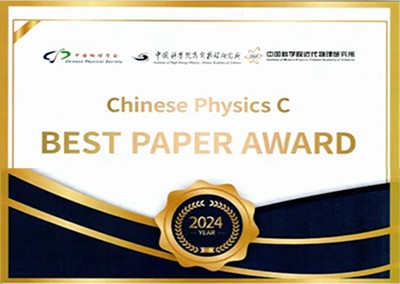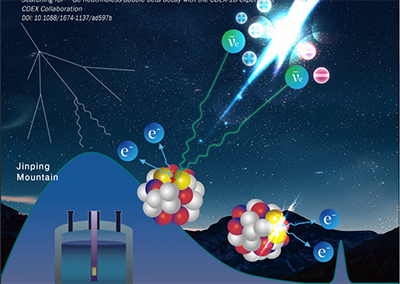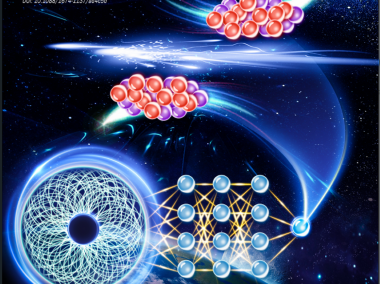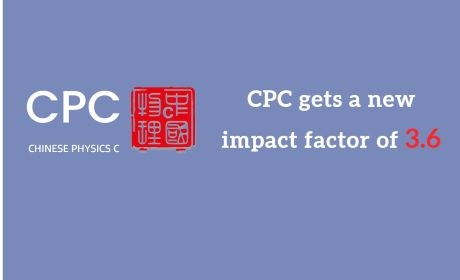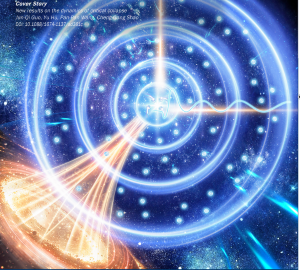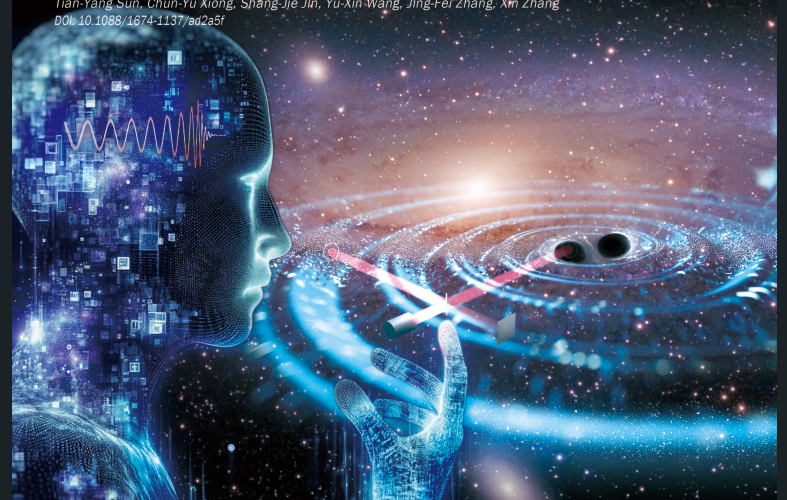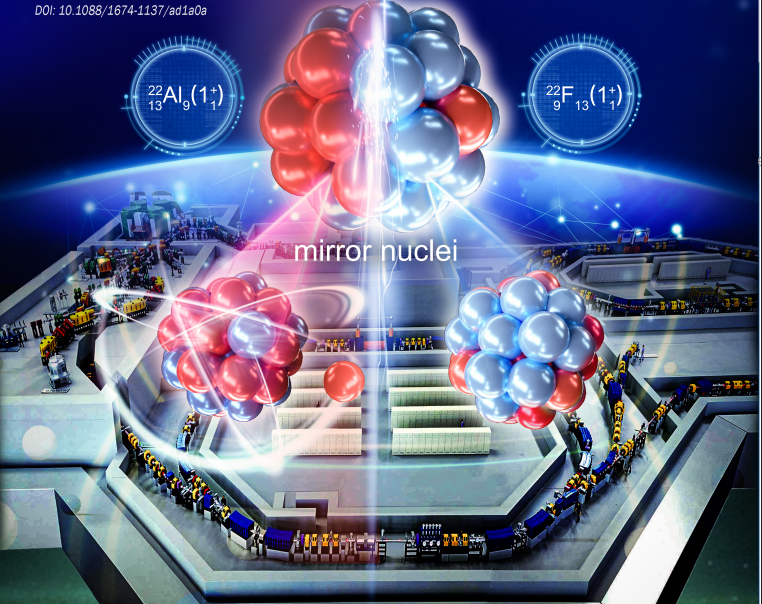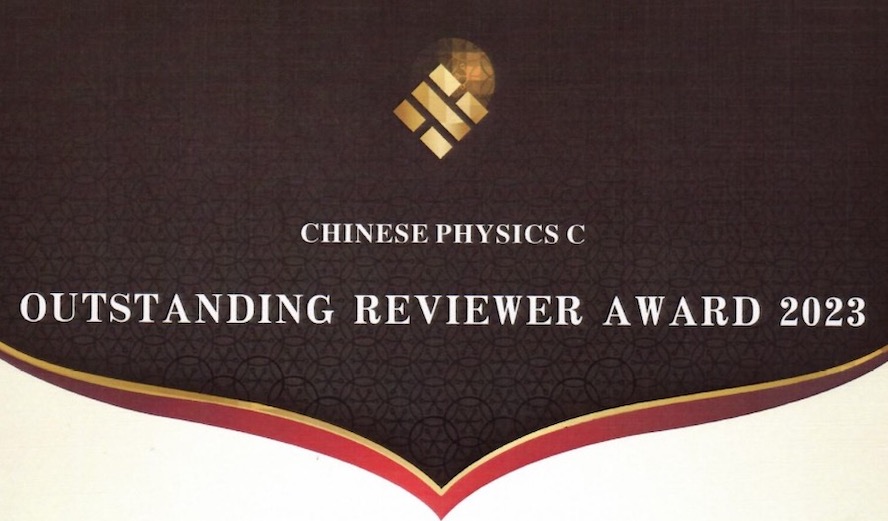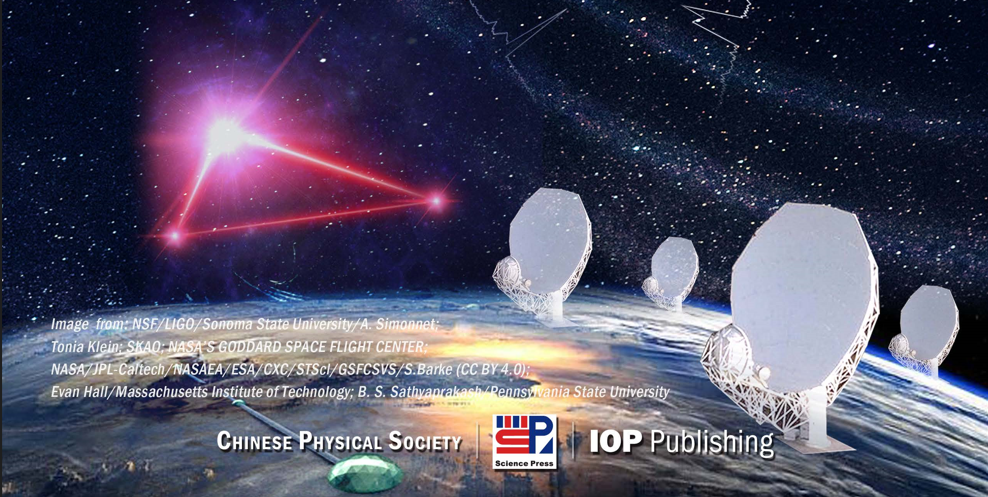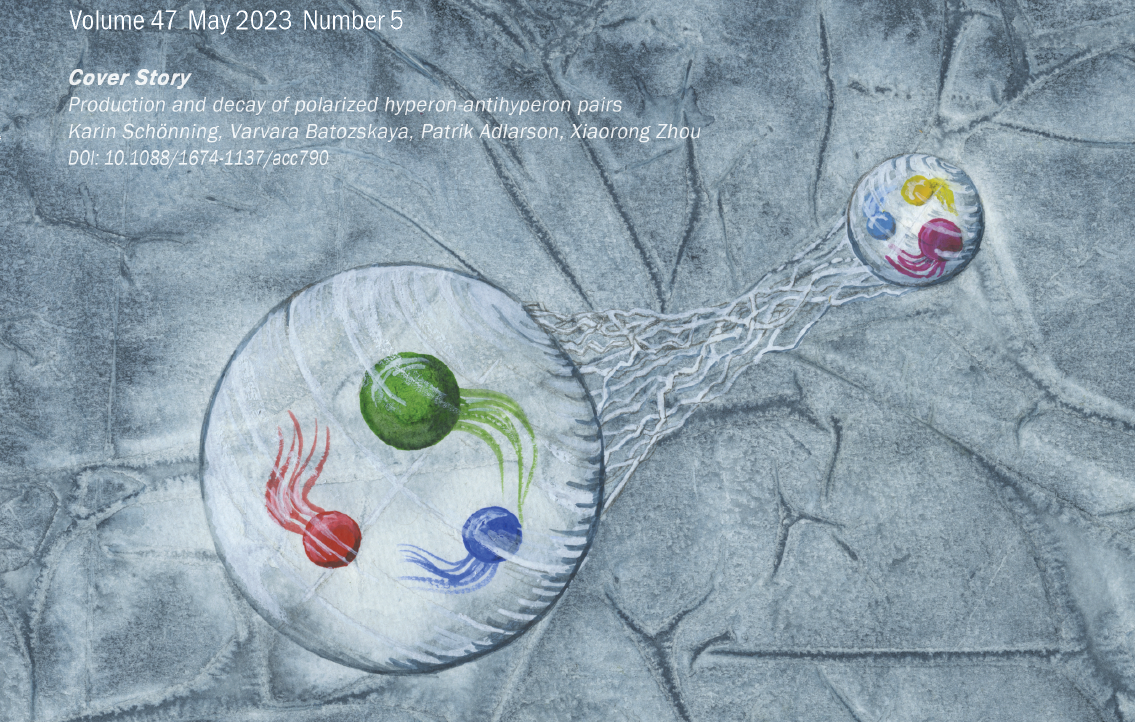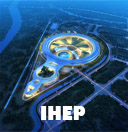Highlights
-
Inferring the spin distribution of binary black holes using deep learning
2024, 48(10): 105102. doi: 10.1088/1674-1137/ad62db
 The spin characteristics of black holes offer valuable insights into the evolutionary pathways of their progenitor stars. This is crucial for understanding the broader population properties of black holes. Traditional hierarchical Bayesian inference techniques employed to discern these properties often demand substantial time, and consensus regarding the spin distribution of binary black hole (BBH) systems remains elusive. In this study, leveraging observations from GWTC-3, we adopted a machine learning approach to infer the spin distribution of black holes within BBH systems. Specifically, we developed a deep neural network (DNN) and trained it using data generated from a Beta distribution. Our training strategy, involving the segregation of data into 10 bins, not only expedites model training but also enhances the versatility and adaptability of the DNN to accommodate the growing volume of gravitational wave observations. Utilizing Monte Carlo-bootstrap (MC-bootstrap) to generate observation-simulated samples, we derived spin distribution parameters:
The spin characteristics of black holes offer valuable insights into the evolutionary pathways of their progenitor stars. This is crucial for understanding the broader population properties of black holes. Traditional hierarchical Bayesian inference techniques employed to discern these properties often demand substantial time, and consensus regarding the spin distribution of binary black hole (BBH) systems remains elusive. In this study, leveraging observations from GWTC-3, we adopted a machine learning approach to infer the spin distribution of black holes within BBH systems. Specifically, we developed a deep neural network (DNN) and trained it using data generated from a Beta distribution. Our training strategy, involving the segregation of data into 10 bins, not only expedites model training but also enhances the versatility and adaptability of the DNN to accommodate the growing volume of gravitational wave observations. Utilizing Monte Carlo-bootstrap (MC-bootstrap) to generate observation-simulated samples, we derived spin distribution parameters:$\alpha=1.3^{+0.25}_{-0.18},\;\beta=1.70^{+0.24}_{-0.29}$ for the larger BH sample and$\alpha=1.37^{+0.31}_{-0.20},\;\beta=1.63^{+0.30}_{-0.20}$ for the smaller BH sample. Within our constraints, the distributions of component spin magnitudes suggest the likelihood of both black holes in the BBH merger possessing non-zero spin. -
Dependence of thermodynamic quantities at freeze-out on pseudorapidity and collision energy in p-p collisions at LHC energies
2024, 48(10): 104107. doi: 10.1088/1674-1137/ad62da
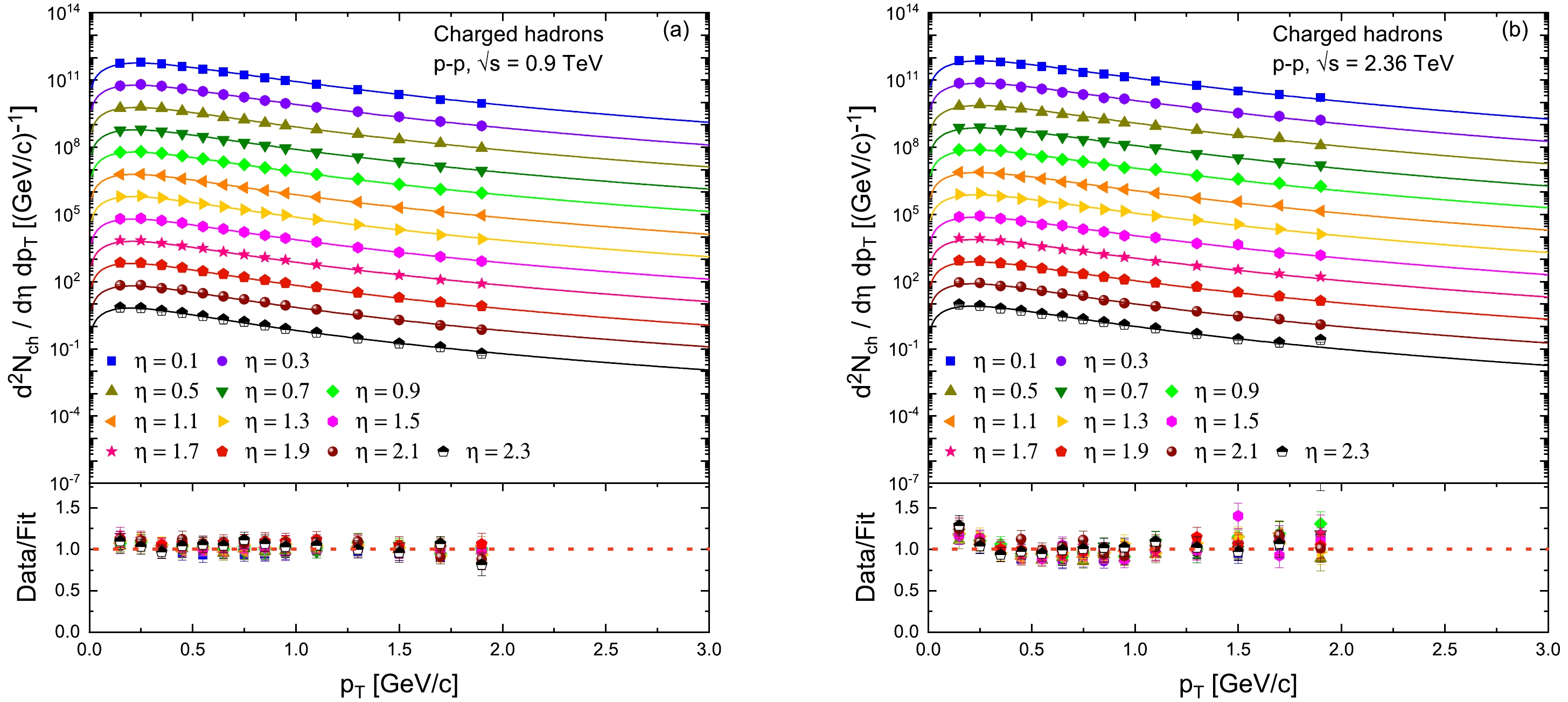 The transverse momentum distributions of charged hadrons produced in proton-proton collisions at center-of-mass energies (
The transverse momentum distributions of charged hadrons produced in proton-proton collisions at center-of-mass energies ($\sqrt{s}$ ) of 0.9 TeV and 2.36 TeV, as measured by the CMS detector at the Large Hadron Collider (LHC), have been analyzed within various pseudorapidity classes utilizing the thermodynamically consistent Tsallis distribution. The fitting procedure resulted in the key parameters, namely, effective temperature (T), non-extensivity parameter (q), and kinetic freezeout volume (V). Additionally, the mean transverse momentum ($ \langle p_T\rangle $ ) and initial temperature (Ti) of the particle source are determined through the fit function and string percolation method, respectively. An alternative method is employed to calculate the kinetic freezeout temperature ($ T_0 $ ) and transverse flow velocity ($ \beta_T $ ) from T. Furthermore, thermodynamic quantities at the freezeout, including energy density (ε), particle density (n), entropy density (s), pressure (P), and squared speed of sound (${C_s}^2$ ), are computed using the extracted T and q. It is also observed that, with a decrease in pseudorapidity, all thermodynamic quantities except V and q increase. This trend is attributed to greater energy transfer along the mid pseudorapidity. q increases towards higher values of pseudorapidity, indicating that particles close to the beam axis are far from equilibrium. Meanwhile, V remains nearly independent of pseudorapidity. The excitation function of these parameters (q) shows a direct (inverse) correlation with collision energy. The ε, n, s, and P show a strong dependence on collision energies at low pseudorapidities. Explicit verification of the thermodynamic inequality$\varepsilon \geqslant 3 P$ suggests the formation of a highly dense droplet-like Quark-Gluon Plasma (QGP). Additionally, the inequality$T_i > T > T_0$ is explicitly confirmed, aligning with the evolution of the produced fireball. -
A simple model for two-proton radioactivity
2024, 48(10): 104108. doi: 10.1088/1674-1137/ad6417
 In this work, considering the preformation factor of the emitted two protons in parent nucleus
In this work, considering the preformation factor of the emitted two protons in parent nucleus$ {S}_{ 2p} $ and the effect of the parent nucleus deformation, based on the Wentzel-Kramers-Brillouin approximation and Bohr-Sommerfeld quantization condition, we improve a simple phenomenological model proposed by Bayrak [J. Phys. G: 47, 025102 (2020)] to systematically study$ 2p $ radioactivity half-lives. This model contains two adjustable parameters$ V_0 $ and$ a_{\beta} $ , which are related to the depth of nuclear potential and effect of deformation. The calculated results show that this model can effectively reproduce the experimental data with a corresponding root-mean-square (RMS) standard deviation of σ = 0.683. For comparison, we include the Gamow-like model (GLM) proposed by Liu et al. [Chin. Phys. C 45, 044110 (2021)], generalized liquid drop model (GLDM) proposed by Cui et al. [Phys. Rev. C 101, 014301 (2020)], effective liquid drop model (ELDM) proposed by M. Gonalves et al. [Phys. Lett. B 774, 14 (2017)], two-potential approach with Skyrme-Hartree-Fock (TPASHF) proposed by Pan et al. [Chin. Phys. C 45, 124104 (2021)], phenomenological model with a screened electrostatic barrier (SEB) propoesed by Zou et al. [Chin. Phys. C 45, 104101 (2021)], unified fission model (UFM) proposed by Xing et al. [Chin. Phys. C 45, 124105 (2021)], Coulomb and proximity potential model for deformed nuclei (CPPMDN) proposed by Santhosh [Phys. Rev. C 104, 064613 (2021)], two-parameter empirical formula proposed by Liu et al. [Chin. Phys. C 45, 024108 (2021)], and four-parameter empirical formula proposed by Sreeja et al. [Eur. Phys. J. A 55, 33 (2019)]. In addition, we use this model to predict the$ 2p $ radioactive half-lives of some possible potential nuclei whose$ 2p $ radioactivity are energetically allowed or observed but not yet quantified in NUBASE2020.
Just Accepted
More >
-
Study of the semileptonic decays
${{\boldsymbol\Upsilon}({\bf 1}{\boldsymbol S}){\bf\to}{\boldsymbol B}_{(\boldsymbol c)}{\boldsymbol\ell}\bar{\boldsymbol\nu}_{\boldsymbol\ell}} $ Published: 2024-10-15 -
Mass ladder operators and quasinormal modes of the static BTZ-like black hole in the Einstein-bumblebee gravity
Published: 2024-10-15
-
Prediction of Energy Resolution in the JUNO Experiment
Published: 2024-10-15
Recent
More >
-
Investigating the level structure of 206Rn: evolution from seniority regime to collective dynamics
2024, 48(11): 114001-114001-11. doi: 10.1088/1674-1137/ad666aShow AbstractExcited states of
$ ^{206} {\rm{Rn}}$ have been examined via the$ ^{197} {\rm{Au}}$ ($ ^{14} {\rm{N}}$ , 5n)$ ^{206} {\rm{Rn}}$ fusion reaction at a beam energy of 78 MeV. A number of transitions and levels are identified by the γ-γ coincidence measurement, further enriching the level scheme of$ ^{206} {\rm{Rn}}$ . The full configuration shell model and nucleon-pair approximation (NPA) were utilized to investigate the single-particle configurations and seniority structures in$ ^{206} {\rm{Rn}}$ . The results of these two calculations suggest that$ 2_1^{+} $ and$ 4_1^{+} $ states exhibit only a 50% component of a seniority-two state associated with a broken neutron pair. The collectivity of these two states primarily arises from configuration mixing due to residual proton-neutron interactions. Furthermore,$ 6_1^{+} $ and$ 8_1^{+} $ states are predominantly characterized by a seniority-two state marked by a broken proton pair. -
FLRW cosmology in metric-affine F(R,Q) gravity
2024, 48(12): 125101-125101-15. doi: 10.1088/1674-1137/ad6e62Show AbstractWe investigated some Friedmann-Lemaître-Robertson-Walker (FLRW) cosmological models in the context of metric-affine
$F(R,Q)$ gravity, as proposed in [arXiv: 1205.5266v6]. Here, R and Q are the curvature and nonmetricity scalars using non-special connections, respectively. We obtained the modified field equations using a flat FLRW metric. We then found a connection between the Hubble constant$H_{0}$ , density parameter$\Omega_{m0}$ , and other model parameters in two different situations involving scalars u and w. Next, we used new observational datasets, such as the cosmic chronometer (CC) Hubble and Pantheon SNe Ia datasets, to determine the optimal model parameter values through a Markov chain Monte Carlo (MCMC) analysis. Using these best-fit values of the model parameters, we discussed the results and behavior of the derived models. Further, we discussed the Akaike information criterion (AIC) and Bayesian information criterion (BIC) for the derived models in the context of the Lambda cold dark matter (ΛCDM). We found that the geometrical sector dark equation of state parameter$\omega_{de}$ behaves just like a dark energy candidate. We also found that both models are transit phase models. Model-I approaches the ΛCDM model in the late-time universe, whereas Model-II approaches quintessence scenarios. -
Stability analysis of static spherical spacetime in extended symmetric teleparallel gravity
2024, 48(12): 125103-125103-11. doi: 10.1088/1674-1137/ad745bShow AbstractOur manuscript aims to analyze the viability and stability of anisotropic stellar objects in the modified symmetric teleparallel gravity. A particular model of this extended theory is considered to formulate explicit field equations that govern the interaction between matter and geometry. The configuration of static spherical symmetric structures is examined through the Finch-Skea solution. However, the values of unknown constants in the metric potentials are evaluated by the Darmois junction conditions. For the viability of the proposed stellar objects, physical parameters including density, pressure, anisotropy, mass, energy constraints, compactness function, and redshift are analyzed. Furthermore, the stability of the proposed stellar objects is investigated by the causality condition, Herrera cracking approach, and adiabatic index. Our findings indicate that the proposed stellar objects are viable as well as stable in the presence of correction terms.
Archive
ISSN 1674-1137 CN 11-5641/O4
Original research articles, Ietters and reviews Covering theory and experiments in the fieids of
- Particle physics
- Nuclear physics
- Particle and nuclear astrophysics
- Cosmology
Author benefits
- A SCOAP3 participating journal - free Open Access publication for qualifying articles
- Average 24 days to first decision
- Fast-track publication for selected articles
- Subscriptions at over 3000 institutions worldwide
- Free English editing on all accepted articles
News
- Chinese Physics C Outstanding Reviewer Award 2023
- Impact factor of Chinese Physics C is 3.6 in 2022
- 2022 CPC Outstanding Reviewer Awards
- The 2023 Chinese New Year-Office closure
- 《Chinese Physics C》BEST PAPER AWARDS 2022
Cover Story
- Cover Story (Issue 9, 2024) Measurement of solar pp neutrino flux using electron recoil data from PandaX-4T commissioning run
- Cover Story (Issue 2, 2024) | Quark/gluon taggers light the way to new physics
- Cover Story (Issue 8, 2024) | Applyingdeep learning technique to chiral magnetic wave search
- Cover Story (Issue 7, 2024) | Unveiling the Mysteries of Hyperon Interactions: Insights from BESIII
- Cover Story (Issue 6, 2024) | Recent development on critical collapse





